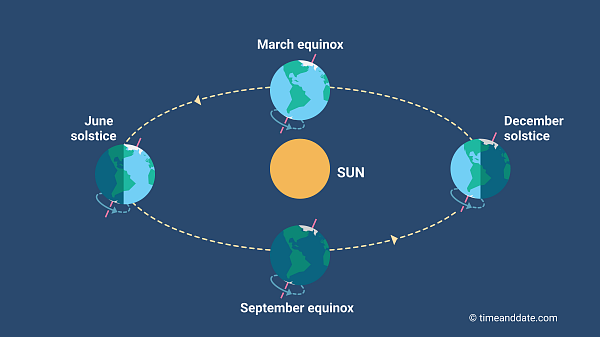Equinox: Earth’s New Year
Astronomers mark the start of our planet’s year on the Spring equinox—March 20 for 2025.


Scientists define an astronomical year as the time between consecutive spring equinox events.
©timeanddate.com
Spring (or Fall) is Sprung by the Sun’s Movement
An astronomical or solar year begins when the Sun appears to move north across the celestial equator (an imaginary line in the sky directly above the terrestrial equator), marking the start of springin the Northern Hemisphere and fall in the southern part of the globe.
The solar year tracks the time between two occurrences of the vernal, or spring, equinox. On average, this totals out to 365 days, 5 hours, 48 minutes, and 45 seconds (but there is a little variation—the timing of our orbit can vary by about 30 minutes from year to year).
Making the Math Easier
Why measure the year from equinox to equinox? It boils down to practical scientific reasons. Astronomers needed to establish a reliable referencepoint to calculate important coordinates in the sky, like right ascension.
Over time, researchers settled on the spring equinox as the point that should kick off the planetary year. The choice of the equinox was similar to the somewhat arbitrary selection of Greenwichas zero degrees longitude on Earth: this was simply a good data pointfor creating precise measurements.
What are longitude and latitude?

Day and night are evenly divided on the equilux, not the equinox.
©iStockphoto.com/JMWScout
Not Quite Equal
The annual spring equinox happens in a three-day window: March 19, 20, or 21 (although time zones can affect this in some places). While many people are familiar with equinox events, there are a few popular misconceptions about what actually happens on the day the seasons shift from winter to spring.
It’s often assumed that an equinox is a day with equal hours of sunlight and darkness, but in fact there is a bit of imbalance. A true 12-hour split of equal day and night actually happens a few days earlier (in the northern hemisphere), on what is known as the equilux.
Equilux: when night and day are equal
Once in Aries, Now in Pisces
In terms of the Zodiac, early astronomers recorded that the astronomical year started with the Sun at the cusp, or First Point, of Aries. This location is one of the two places in the celestial sphere the Sun, travelling along its annual path known as the ecliptic, crosses the celestial equator.
The other solar crossing point is the cusp of Libra, and when the Sun enters the first point of that constellation, it marks the onset of the autumnal equinox (for the northern hemisphere).
But while the cusp of Aries was where the Sunused to be at the March equinox years ago, the effect of precession over time means that we now find the Sun in Pisceswhen the seasons shift.
Precession is a planetary movement. In this case, it describes the Earth’s wobbling motion as it rotates, which is similar to the way a spinning top undulates at times. The precession effect creates a gradual change in the direction of our planet’s rotational axis, and this in turn affects how we see the position of solstice and equinox points in the sky.